Mạng tích chập neural network
Tìm hiểu về kiến trúc và cách cài đặt mạng tích chập neural
Convolution & Correlation
Giới thiệu phép tích chập và phép correlation
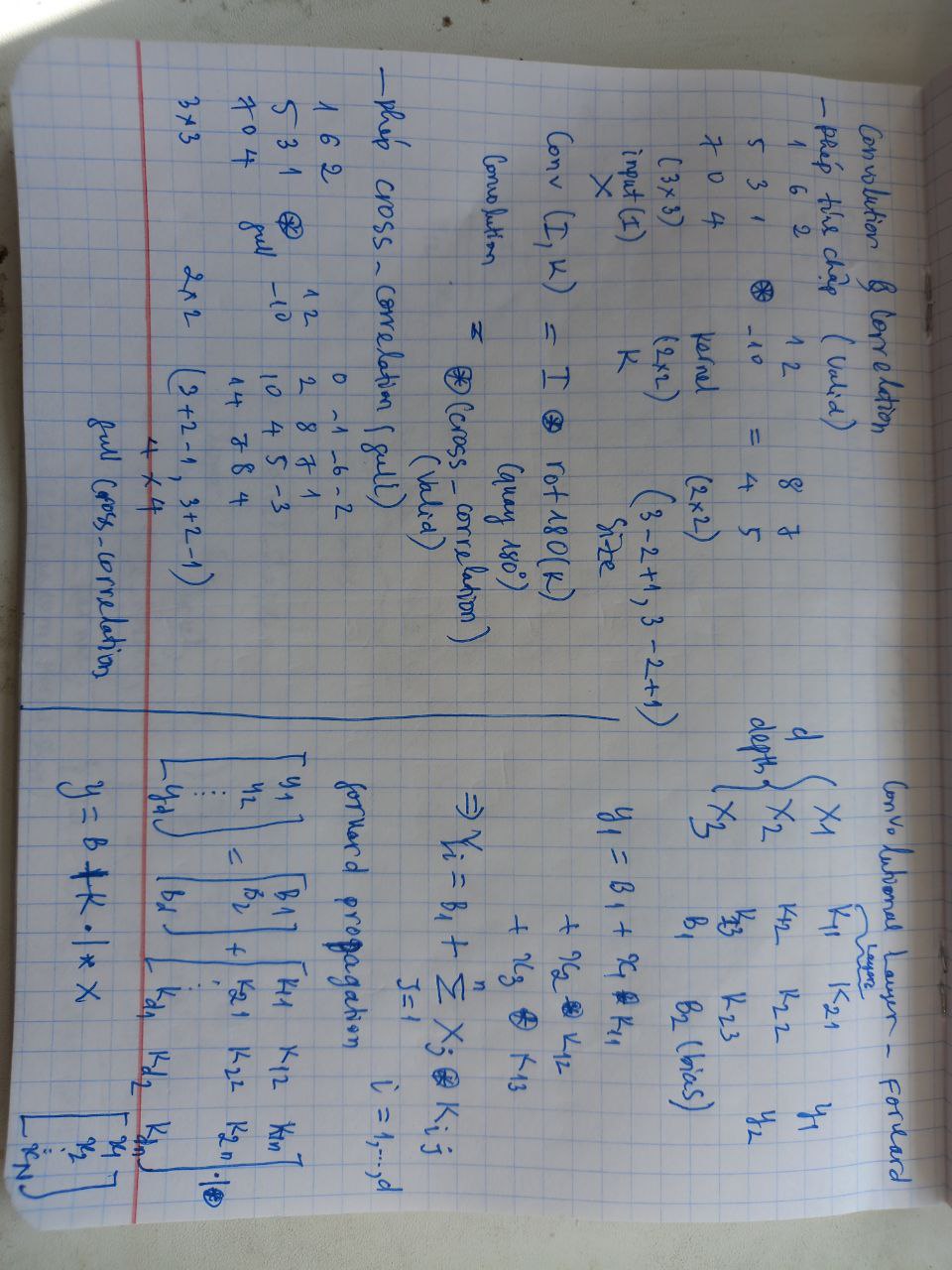
Convolution Layer - Forward
Giới thiệu công thức tính forward
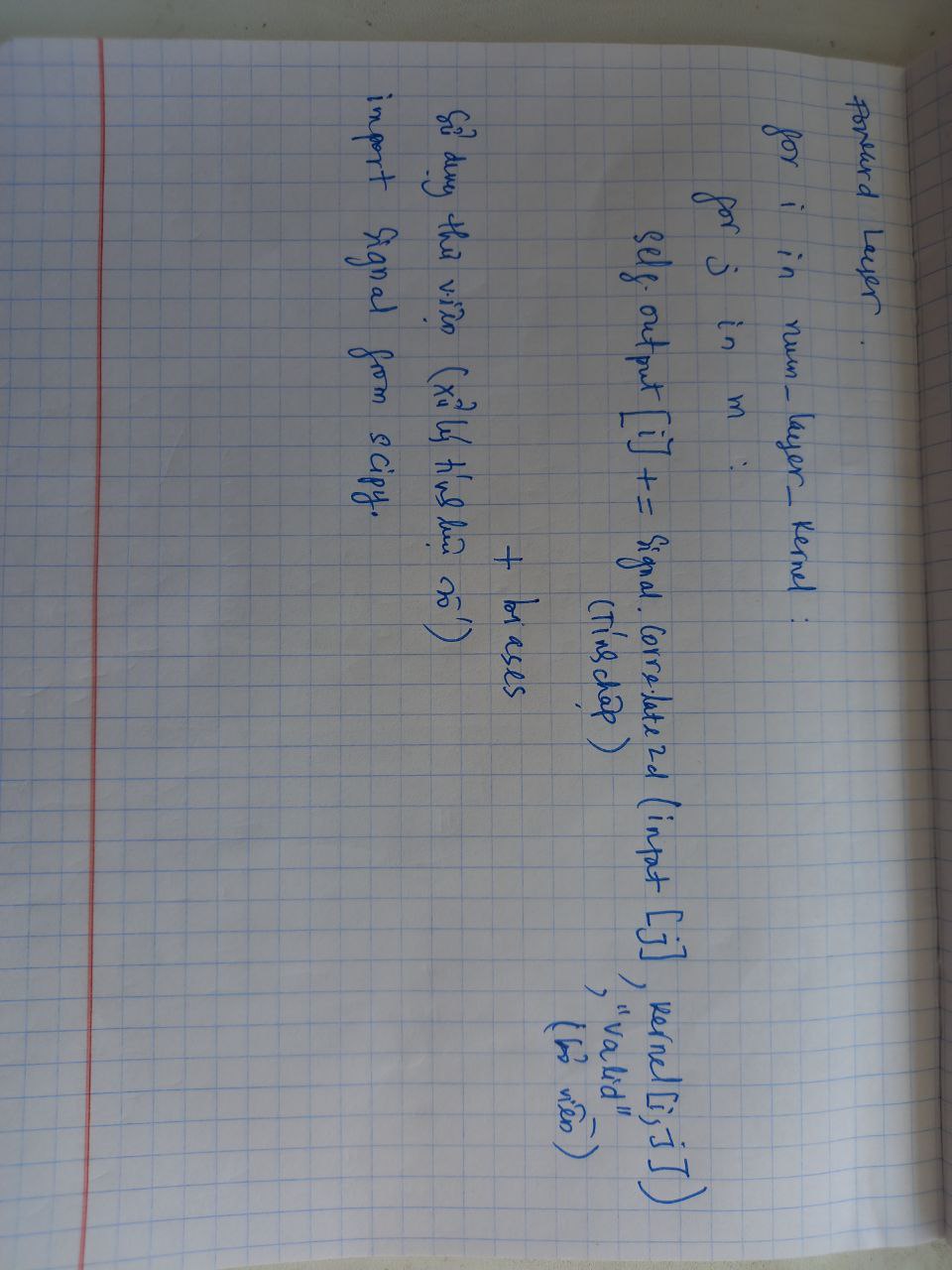
Khởi tạo Convolution
Giải thích và cài đặt
1
2
3
4
5
6
7
8
9
10
11
12
13
14
15
16
17
18
19
20
21
22
23
24
25
26
27
28
29
30
31
32
33
34
35
36
37
38
39
40
41
42
43
44
45
46
47
48
49
50
51
52
53
54
import numpy as np
from scipy import signal
from layer import Layer
class Convolutional(Layer):
# Tinh forward va backward cho lop Convolutional
def __init__(self, input_shape, kernel_size, depth):
input_depth, input_height, input_width = input_shape # (inputshape (m, h, w)
# input_depth: so luong input dau vao (m: size)
# depth: nume_layer_kernel
self.depth = depth
self.input_shape = input_shape
self.input_depth = input_depth
self.output_shape = (depth, input_height - kernel_size + 1, input_width - kernel_size + 1)
self.kernels_shape = (depth, input_depth, kernel_size, kernel_size)
#output_shape (num_layer_kernel, h - size_kernel + 1, w - size_kernel + 1)
#kernel_shape (num_layer_kernel, m, kernel_size, kernel_size)
#kernels (dua tren kernels_shape
self.kernels = np.random.randn(*self.kernels_shape)
#biases (dua tren size output_shape)
self.biases = np.random.randn(*self.output_shape)
def forward(self, input): # input * kernel + bias
# duyet tu num_layer_kernel, duyet cac input dulieu
# tinh tung output[i] (tu dau den cuoi)
self.input = input
self.output = np.copy(self.biases)
for i in range(self.depth):
for j in range(self.input_depth):
self.output[i] += signal.correlate2d(self.input[j], self.kernels[i, j], "valid")
return self.output
# dau vao: output_gradient, learning
# cach tinh da duoc giai thich o cac hinh (back_ward1,2,3,4)
def backward(self, output_gradient, learning_rate):
kernels_gradient = np.zeros(self.kernels_shape)
input_gradient = np.zeros(self.input_shape)
for i in range(self.depth):
for j in range(self.input_depth):
kernels_gradient[i, j] = signal.correlate2d(self.input[j], output_gradient[i], "valid")
input_gradient[j] += signal.convolve2d(output_gradient[i], self.kernels[i, j], "full")
self.kernels -= learning_rate * kernels_gradient
self.biases -= learning_rate * output_gradient
return input_gradient
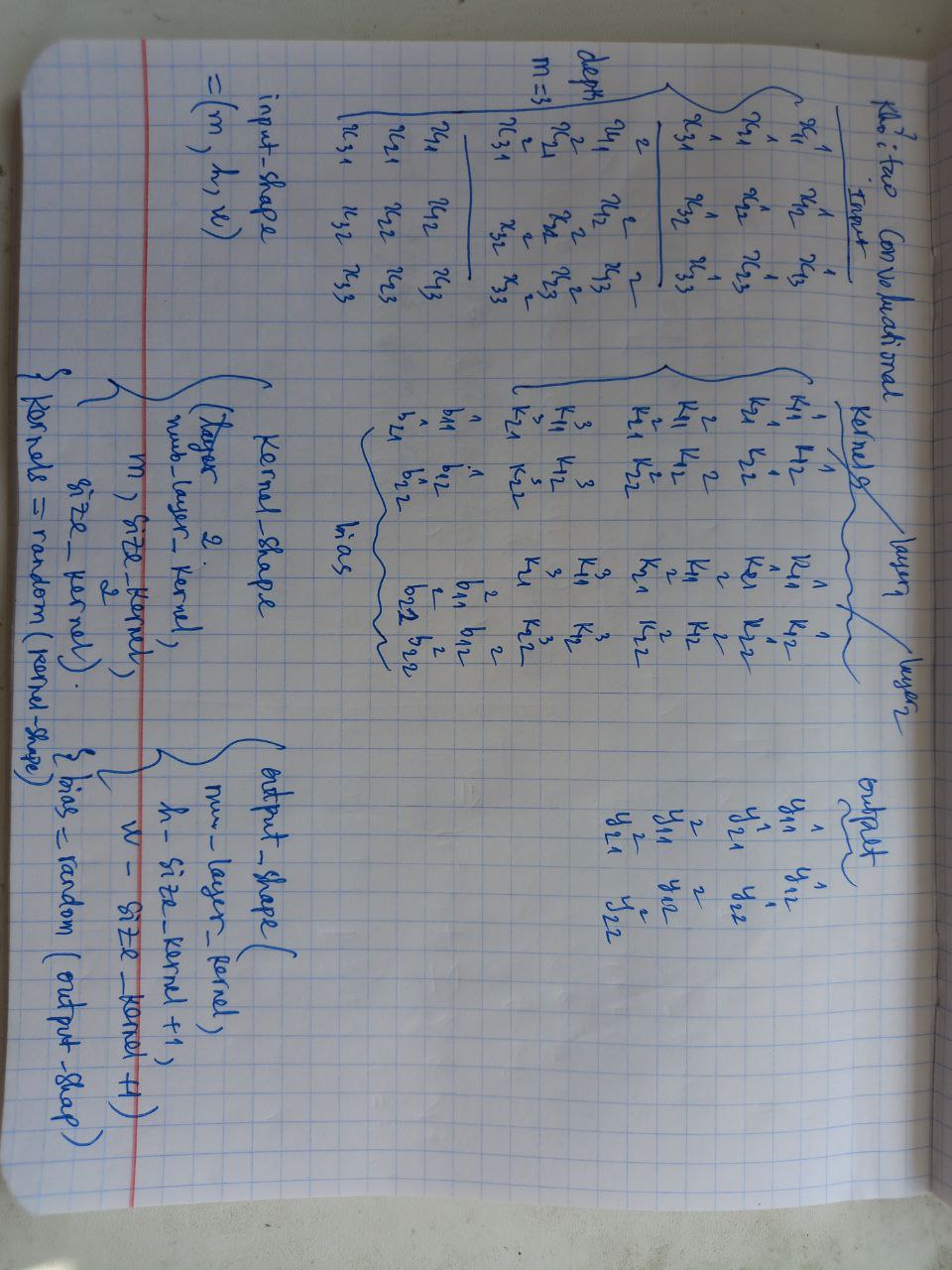
Hàm lỗi và đạo hàm
Cách tính hàm lỗi và đạo hàm
1
2
3
4
5
6
7
8
9
10
11
12
13
14
15
16
17
18
import numpy as np
# Do loi mse (binh phuong do lech)
def mse(y_true, y_pred):
return np.mean(np.power(y_true - y_pred, 2))
# Dao ham cua mse giua (y_true vs y_pred)
def mse_prime(y_true, y_pred):
return 2 * (y_pred - y_true) / np.size(y_true)
# Gia tri cua ham loi giua y_true vs y_pred (predict)
def binary_cross_entropy(y_true, y_pred):
return np.mean(-y_true * np.log(y_pred) - (1 - y_true) * np.log(1 - y_pred))
# Dao ham cua ham loi giua y_true va y_predict
def binary_cross_entropy_prime(y_true, y_pred):
return ((1 - y_true) / (1 - y_pred) - y_true / y_pred) / np.size(y_true)
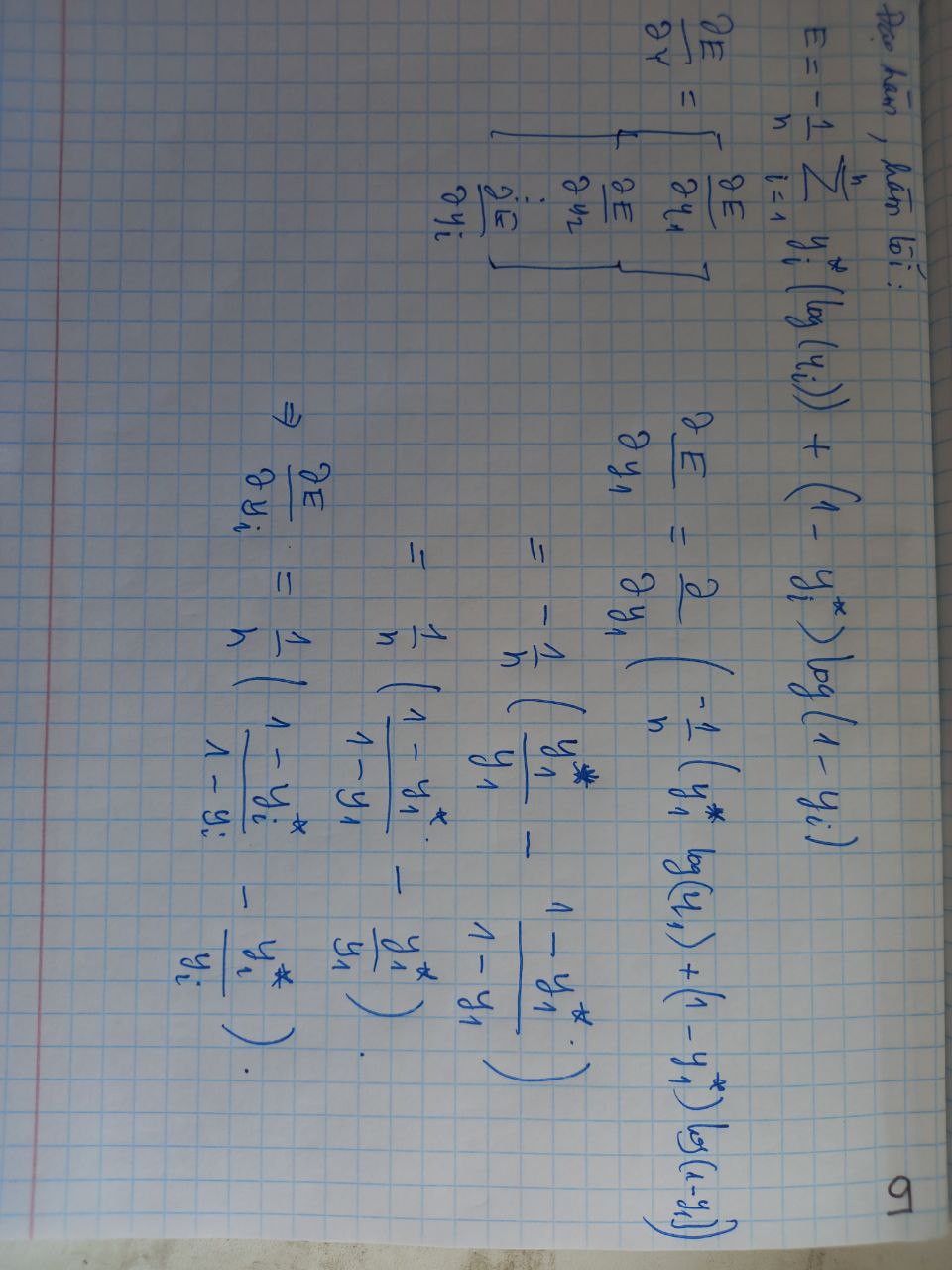
Phương pháp backward (đối với convolution)
toán học và cài đặt
1
2
3
4
5
6
7
8
9
10
11
12
def backward(self, output_gradient, learning_rate):
kernels_gradient = np.zeros(self.kernels_shape)
input_gradient = np.zeros(self.input_shape)
for i in range(self.depth):
for j in range(self.input_depth):
kernels_gradient[i, j] = signal.correlate2d(self.input[j], output_gradient[i], "valid")
input_gradient[j] += signal.convolve2d(output_gradient[i], self.kernels[i, j], "full")
self.kernels -= learning_rate * kernels_gradient
self.biases -= learning_rate * output_gradient
return input_gradient
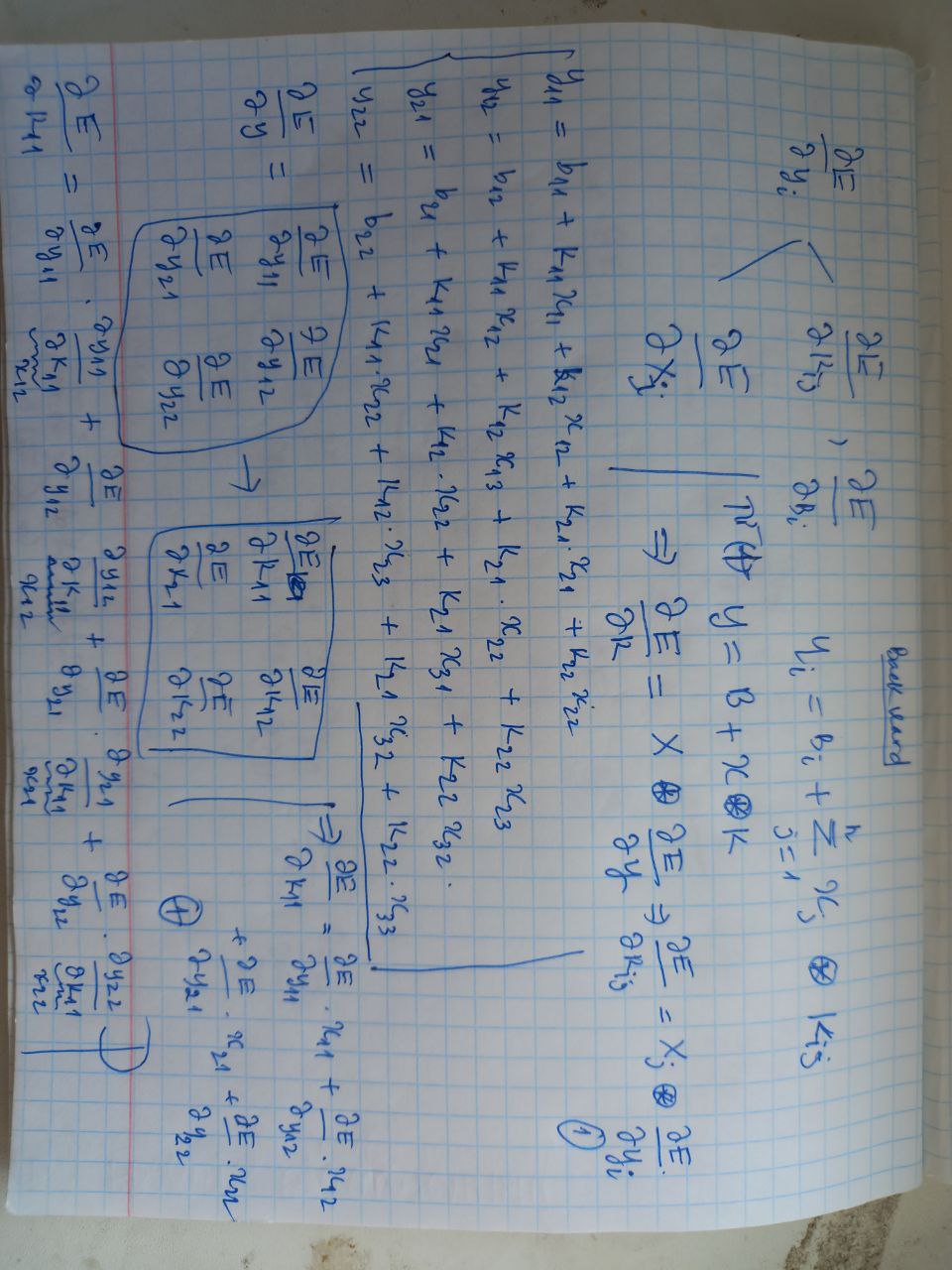
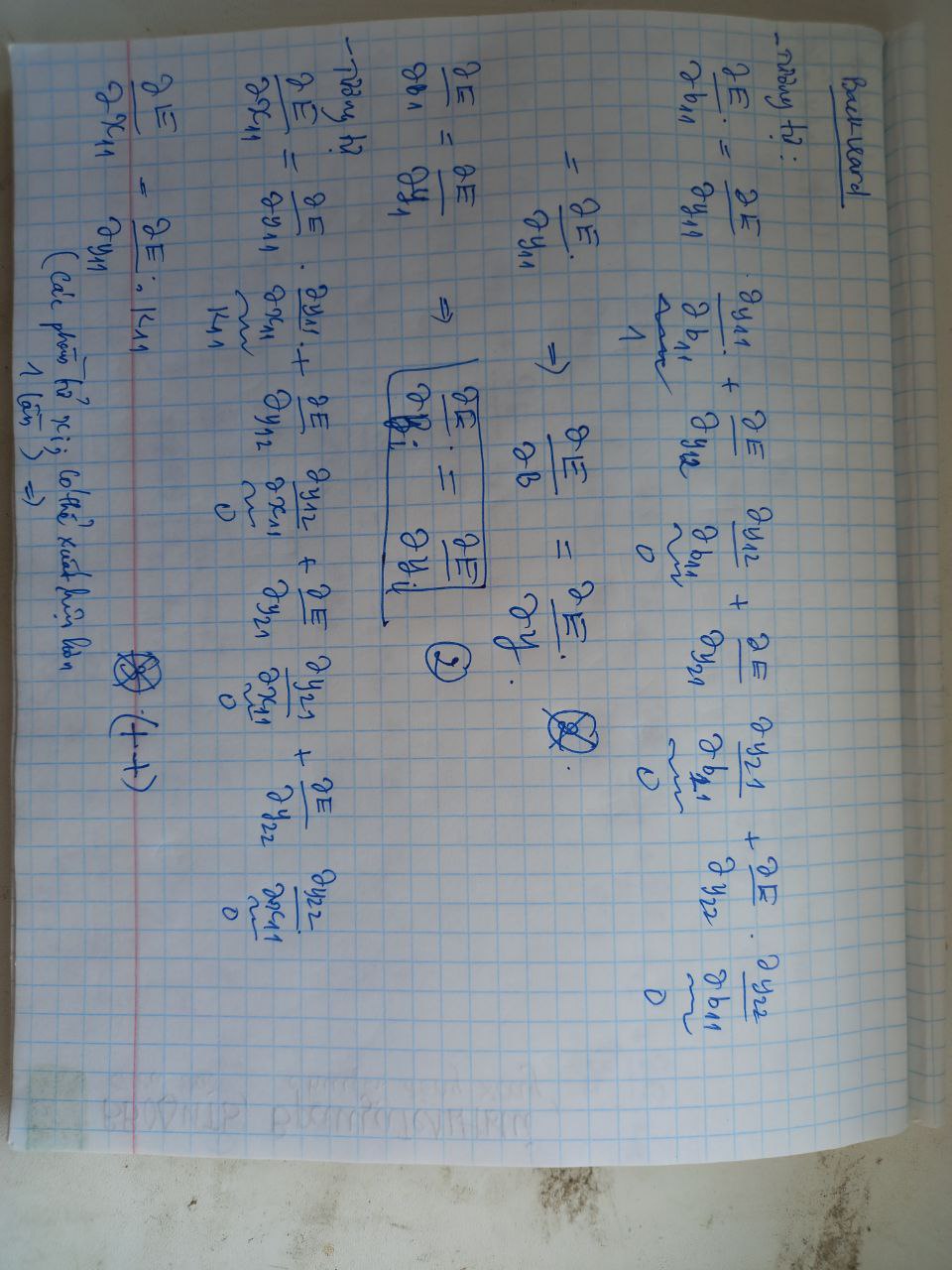
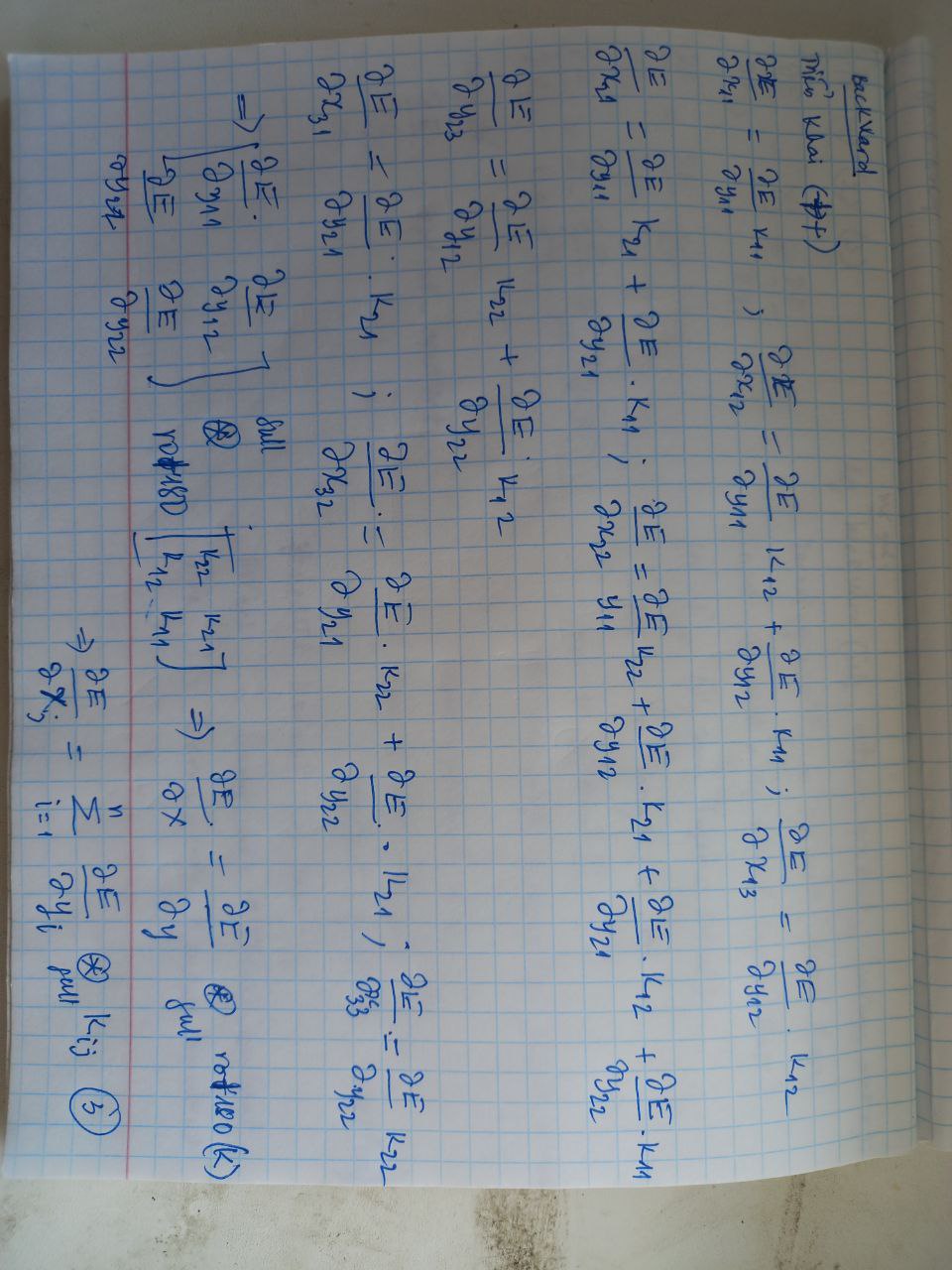

Cài đặt đầy đủ CNN (cài từ đầu)
Class Layer (base)
1
2
3
4
5
6
7
8
9
10
11
12
13
14
15
16
17
18
# Lop base (Layer) gom co input, output
# method forward (input) --> "dao ham tien"
# method backward (output_gradient, learning rate) --> "dao ham nguoc"
# Cac lop ke thua lop (Layer) phai dinh nghia lai forward va backward
class Layer:
def __init__(self):
self.input = None
self.output = None
def forward(self, input):
# TODO: return output
pass
def backward(self, output_gradient, learning_rate):
# TODO: update parameters and return input gradient
pass
Hàm Activations
Cài đặt các hàm activation
1
2
3
4
5
6
7
8
9
10
11
12
13
14
15
16
17
18
19
import numpy as np
from layer import Layer
# Lop Activation (ke thua Layer)
# Activation (actionvation function, activation prime - dao ham)
class Activation(Layer):
def __init__(self, activation, activation_prime):
self.activation = activation #ham activation
self.activation_prime = activation_prime # dao ham cua ham activation tuong ung.
# Khi forward no se call ham activation cho input dua vao
def forward(self, input):
self.input = input
return self.activation(self.input)
# Khi backward no thuc hien phep mul giua output_gradient vs activation_prime cua input
def backward(self, output_gradient, learning_rate):
return np.multiply(output_gradient, self.activation_prime(self.input))
Cài đặt 2 hàm actionvation: Tanh, Sigmoid
1
2
3
4
5
6
7
8
9
10
11
12
13
14
15
16
17
18
19
20
21
22
23
24
25
26
27
28
29
30
31
32
33
34
35
36
37
38
39
40
41
42
43
44
45
46
47
48
49
50
import numpy as np
from layer import Layer
from activation import Activation
# Ham Tanh va sigmoid (2 ham nay la ham activation)
# Ham Tanh (ke thua Lop Activation)
# Dinh nghia ham Tanh va dao ham cua ham Tanh tuong ung
class Tanh(Activation):
def __init__(self):
def tanh(x):
return np.tanh(x)
def tanh_prime(x):
return 1 - np.tanh(x) ** 2
super().__init__(tanh, tanh_prime)
# Dinh nghia ham sigmoid va dao ham cua ham sigmoid
class Sigmoid(Activation):
def __init__(self):
def sigmoid(x):
return 1 / (1 + np.exp(-x))
def sigmoid_prime(x):
s = sigmoid(x)
return s * (1 - s)
super().__init__(sigmoid, sigmoid_prime)
# Lop softmax ke thua tu lop (Layer)
# Dinh nghia lai ham forward vs backward
# Softmax la mot Layer (no can duoc dinh nghia forward va backward)
class Softmax(Layer):
# forward: x^e / sum (x^e)
def forward(self, input):
tmp = np.exp(input)
self.output = tmp / np.sum(tmp)
return self.output
# Day la cong thuc tinh backward theo softmax
def backward(self, output_gradient, learning_rate):
# This version is faster than the one presented in the video
n = np.size(self.output)
return np.dot((np.identity(n) - self.output.T) * self.output, output_gradient)
# Original formula:
# tmp = np.tile(self.output, n)
# return np.dot(tmp * (np.identity(n) - np.transpose(tmp)), output_gradient)
Util Reshape.py
1
2
3
4
5
6
7
8
9
10
11
12
13
14
15
16
17
import numpy as np
from layer import Layer
# Reshape (no cung la mot Layer), can dinh nghia la forward vs backward
class Reshape(Layer):
# input cua Reshape la (input_shape, output_shape)
def __init__(self, input_shape, output_shape):
self.input_shape = input_shape
self.output_shape = output_shape
# qua trinh forward (input) --> reshape input theo (output_shape)
def forward(self, input):
return np.reshape(input, self.output_shape)
# qua trinh backward --> no reshape output_gradient theo dang (input_shape)
def backward(self, output_gradient, learning_rate):
return np.reshape(output_gradient, self.input_shape)
Lớp Dense
1
2
3
4
5
6
7
8
9
10
11
12
13
14
15
16
17
18
19
20
21
22
23
24
25
26
27
28
29
30
31
32
import numpy as np
from layer import Layer
# Lop Dense cung la mot Layer
class Dense(Layer):
# ham khoi tao (input_sie, vs output_size)
# --> sinh ra weights (output_size, input_size)
# --> bias (output_size, 1)
def __init__(self, input_size, output_size):
self.weights = np.random.randn(output_size, input_size)
self.bias = np.random.randn(output_size, 1)
# forward: tinh tich "dot" cua weights vs input + bias
def forward(self, input):
self.input = input
return np.dot(self.weights, self.input) + self.bias
# backward: tim lai input_gradient
# du lieu dau vao (output_gradient, learning_rate)
# cap nhat weigths vs bias (nguoc dau voi dao ham)
def backward(self, output_gradient, learning_rate):
# gradient cua weigths chinh la tich "dot" output_gradient vs intput.T
weights_gradient = np.dot(output_gradient, self.input.T)
# input_gradient chinh la tich "dot" cua weights.T vs output_gradient
input_gradient = np.dot(self.weights.T, output_gradient)
# cap nhat weights vs bias
self.weights -= learning_rate * weights_gradient
self.bias -= learning_rate * output_gradient
return input_gradient
Cài đặt network
Cài đặt phương thức train và predict
1
2
3
4
5
6
7
8
9
10
11
12
13
14
15
16
17
18
19
20
21
22
23
24
25
26
27
28
29
30
31
32
33
34
35
36
def predict(network, input):
# input: dau vao de predict
# network: mang da co.
output = input
# duyet qua tung layer --> tinh forward den cuoi cung
# --> output tuong ung voi input dau vao.
for layer in network:
output = layer.forward(output)
return output
def train(network, loss, loss_prime, x_train, y_train, epochs = 1000, learning_rate = 0.01, verbose = True):
# duyet tu epochs
for e in range(epochs):
error = 0
# moi epochs tinh lai error
# duyet toan bo tap train
for x, y in zip(x_train, y_train):
# forward
output = predict(network, x)
# error
error += loss(y, output)
# backward
grad = loss_prime(y, output)
# duyet nguoc netork, tinh backward voi gradient_output (tinh theo ham loss vs loss_prime dua vao)
for layer in reversed(network):
grad = layer.backward(grad, learning_rate)
error /= len(x_train)
if verbose:
print(f"{e + 1}/{epochs}, error={error}")
Hàm Chính
1
2
3
4
5
6
7
8
9
10
11
12
13
14
15
16
17
18
19
20
21
22
23
24
25
26
27
28
29
30
31
32
33
34
35
36
37
38
39
40
41
42
43
44
45
46
47
48
49
50
51
52
53
54
55
56
57
58
import os
os.environ['TF_CPP_MIN_LOG_LEVEL'] = '3'
import numpy as np
from keras.datasets import mnist
from keras.utils import np_utils
from dense import Dense
from convolutional import Convolutional
from reshape import Reshape
from activations import Sigmoid
from losses import binary_cross_entropy, binary_cross_entropy_prime
from network import train, predict
def preprocess_data(x, y, limit):
zero_index = np.where(y == 0)[0][:limit]
one_index = np.where(y == 1)[0][:limit]
all_indices = np.hstack((zero_index, one_index))
all_indices = np.random.permutation(all_indices)
x, y = x[all_indices], y[all_indices]
x = x.reshape(len(x), 1, 28, 28)
x = x.astype("float32") / 255
y = np_utils.to_categorical(y)
y = y.reshape(len(y), 2, 1)
return x, y
# load MNIST from server, limit to 100 images per class since we're not training on GPU
(x_train, y_train), (x_test, y_test) = mnist.load_data()
x_train, y_train = preprocess_data(x_train, y_train, 100)
x_test, y_test = preprocess_data(x_test, y_test, 100)
# neural network
network = [
Convolutional((1, 28, 28), 3, 5),
Sigmoid(),
Reshape((5, 26, 26), (5 * 26 * 26, 1)),
Dense(5 * 26 * 26, 100),
Sigmoid(),
Dense(100, 2),
Sigmoid()
]
# train
train(
network,
binary_cross_entropy,
binary_cross_entropy_prime,
x_train,
y_train,
epochs=20,
learning_rate=0.1
)
# test
for x, y in zip(x_test, y_test):
output = predict(network, x)
print(f"pred: {np.argmax(output)}, true: {np.argmax(y)}")
Link tham khảo
Tài liệu tham khảo
Machine learning cơ bản
Hết.